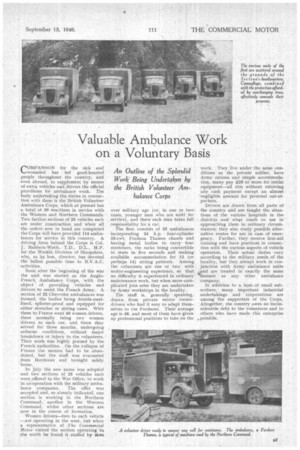Valuable Ambulance Work on a Voluntary Basis
Page 25

If you've noticed an error in this article please click here to report it so we can fix it.
An Outline of the Splendid Work Being Undertaken by the British Volunteer Ambulance Corps
COMPASSION for the sick and ....,wounded has led good-hearted people throughout the country, and even abroad, to supplement by means of extra vehicles and drivers the official proviSions for ambulance work. The body undertaking the duties in connection with these is the British Volunteer Ambulance Corps, which at present has a total of 50 machines in service with the Western and Northern Commands. Two further sections of 25 vehicles each are under construction and when all the orders now in hand are completed the Corps will have provided 114 ambulances for service in this country. A driving force behind the Corps is Col. J. Baldwin-Webb, T.D., D.L., M.P. for the Wrekin Division of Shropshire, who, as its hon. director, has devoted the fullest possible time to B.V.A.C. activities.
Soon after the beginning of the war the unit was started as the AngloFrench, Ambulance Corps, with the ,object of providing vehicles arid drivers to assist the French Army. A section of 22 Chevrolet ambulances was formed, the bodies being double-steellined, splinter-proof and equipped for either stretcher or sitting cases, With them to France went 46 women drivers, there normally being two women drivers to each car, and there they served for three months, undergoing arduous• conditions, without major breakdown or injury to the volunteers. Their work was highly praised by the French authorities. On the collapse of France the motors had to be abandoned, but the staff was evacuated from Bordeaux and brought safely home.
In July the new name was adopted and two sections of 25 vehicles each were offered to the War Office, to work in co-operation with the military ambulance companies. The offer was accepted and, as already indicated, one section is working in the . Northern Command, another in the Western Command, whilst other sections are now in the course of formation.
Women drivers—two to each vehicle —are -operating in the west, but when a representative of The Commercial Motor visited the section operating %hi the north he found it staffed by Mora
over military age (or, in one or two cases, younger men who are unfit for service), and there each man takes full responsibility for a car, The fleet consists of 25 ambulances incorporating 24 h.p. four-cylinder 25-cwt, Fordson Thames chassis and having metal bodies to carry four stretchers, the racks being convertible to seats in five seconds and making available accommodation for 12 (or perhaps 14) sitting patients. Among the volunteers are one or two with motor-engineering experience, so that no difficulty is experienced in ordinary maintenance work, but when more complicated jobs arise they are undertaken by Army workshops in the locality.
The staff is, generally speaking, drawn from private motor ownerdrivers who find it easy to adapt themselves to the Fordsons. Their average age is 48, and most of them have given up professional positions to take on the
work. They live under the same conditions as the private soldier, have Army -rations and simple accoMmodation, many pay £25 or more. for initial equipment—all this without reteiving any cash payment except an almost 'negligible amount for personal out-ofpockets.
Drivers are drawn from all parts of the country and are taught the situations of the various hospitals in the districts and what roads to use in approaching them in ordinary circumstances; they also study possible alternative routes for use in case of emergency. Further, they receive first-aid training and have practices in corioec-tion with the various aspects of vehicle operation. Their actual duties vary according to the military needs of the locality, but they always. work in conjunction with Army ambulance units and are treated in exactly the same manner as any other ambulance company.
In addition to a host.-of small subscribers, many important industrial
• undertakings and corporatibns are among the supporters of the Corps. Altogether, the country owes no inconsiderable debt to the volunteers and to others who have made this enterprise ,rpossible.




















































